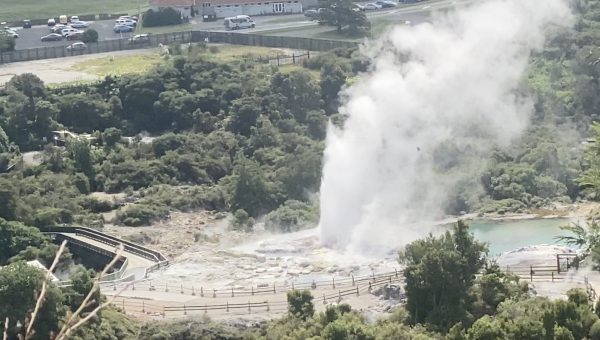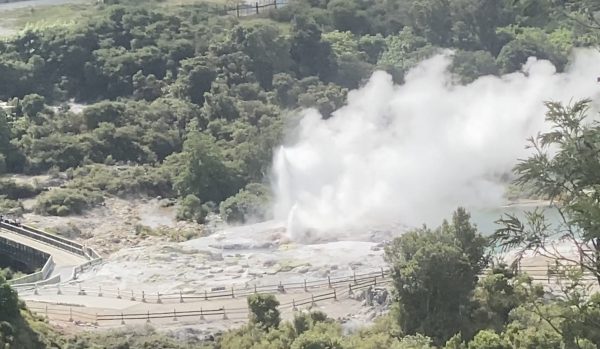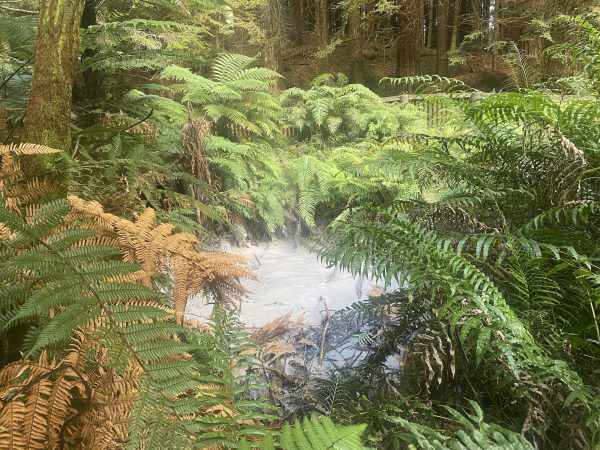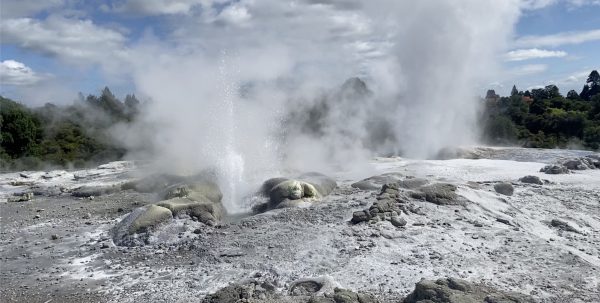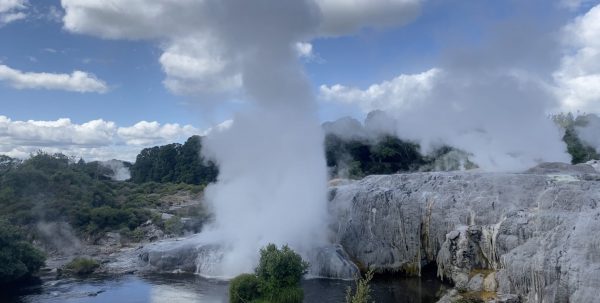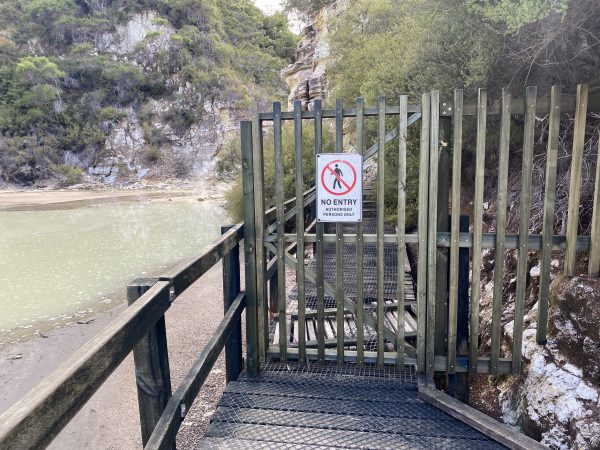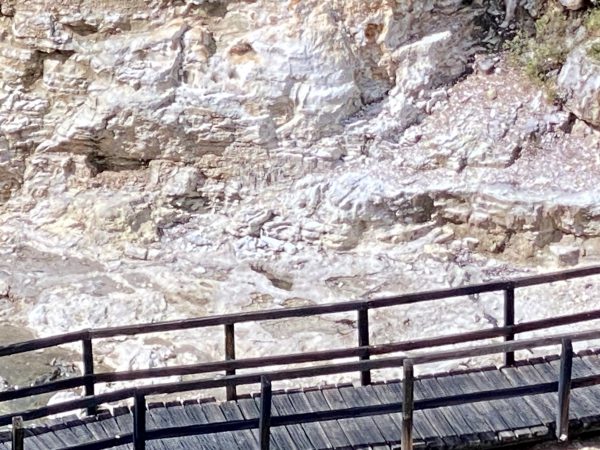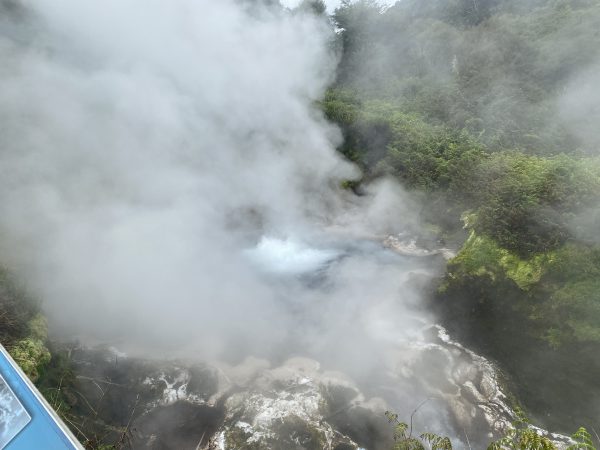Posted on
Tag: Kereru
Posted on
Posted on
Observations for 2023 March 12
Visted the Rotorua lakeshore and the Government Gardens. Once again, most of the features were murky, acid-sulphate springs and formation. Whangapipiro Pool (aka Rachel Spring) was the one clear, alkaline boiling feature behind a rock wall across the street from the lawn bowling and croquet lawns.
On some maps I've seen a trail along the north side of Puarenga Stream north of Whakawerawera. Investigated it and found that other than one large boiling pool, it doesn't provide any better access or views to the features along the stream inside the village.
The afternoon was spent at the geyser overlook along the Pohaturoa Trail in the Whakawerawera Forest Preserve. From there, over a period of about three hours, saw multiple eruptions of all the features on Geyser Flat.
Pohutu seems to have had a short duration eruption, about 15 minutes long, followed by a short interval, about 36 minutes. That eruption was more normal for the last few days, lasting about 45 minutes with an interval of just under 1-1/2 hours. It's interesting that during the last few days, Pohutu was in eruption about half the time, no matter what the duration was.
Saw several series from Mahanga, and again they seemed to be different than previous days, in both length of series and in interval between series. One series was long, about 16 minutes, followed by 34 minutes of quiet. The next series was only a few weak splashes, and then inactivity for 15 minutes. That series duration was almost 20 minutes long, and Mahanga hadn't restarted by the time we left a half hour later.
Finally, we got to see two eruptions of Kereru. The first was a complete surprise, as usual. The second came about 100 minutes later, just as Pohutu was starting. So I should have gotten it on video, but unfortunately I was so zoomed in that the view was bouncing around and I was watching the geysers, not the little screen. So I didn't get much more than some nice still shots.
In any case, we have seen Kereru on four different days, and pairs of eruptions with intervals ranging from around 70 minutes to about two hours. I'd say that Kereru is quite active, or we got extremely lucky.
On the way back, we visited one last thermal feature. Deep in the forest of non-native California Redwoods is a small mudpot. It's probably one of the most unusual settings for a thermal feature that I've encountered.
Posted on
Observations for 2023 March 09
Today we returned to the Whakarewarewa thermal area, but on the Maori village side. We got a late start because we misunderstood the types of tours offered. You can't see Korotiotio and Parekohoru on the Geothermal Walks self-guided tour, but need to take the Village Legacy Tour. But that also includes access to the Pohutu viewpoint, where we spent much of our time.
The view of the Geyser Flat, while not close, is still pretty good. You can see enough of Kereru to get an idea of what it is doing, and Mahanga is visible at the same time. We arrived there while Pohutu was active. It was probably early in the eruption of Pohutu, because it continued to erupt for half an hour. We saw the start of a Mahanga series which lasted about 12 minutes.
After 45 minutes or so, Te Tohu started, and almost immediately, we also got an eruption of Kereru. As in the other times we've see it erupt, it seemed to have been quiet before the eruption. Afterwards, it was having strong minors for the next hour or so.
Two hours later, an eruption of Pohutu had come and gone. There were three series of Mahanga eruptions, lasting from 9 to 14 minutes. Pohutu had been erupting for about 12 minutes, and it was three minutes short of two hours when we got to see a second Kereru eruption.
At that point, we took our Geothermal Walk. The area covered is large, with numerous hot pools with occasional mudpots and areas of what appear to be perpetual spouters. The underbrush is thick is many places, hiding features so much that you can hear them, but not see them.
Since we still had an hour before closing, we went back to the overlook, but were blocked out by some tours. By the time we got to the platform, it looked like Kereru was finishing an eruption. Over the next hour, it had many strong minors. Some of these would put up jets of water well above the higher Geyser Flat platform. If that was an eruption, then the interval was about 1-1/2 hour, which fits our previous experiences.
During that time watching the minors, we saw Mahanga end a series, then have another that was still going 19 minutes later, when we finally had to leave the area. At that time Pohutu was still about ten minutes away from another eruption.
Posted on
Observations for 2023 March 06
Before we entered the reserve, we did see Pohutu erupting from the same parking lot as yesterday. Looked like it might have been near the start, as it was quite tall.
Inside Te Puia, before you can wander about watching geysers you must first take the 1-1/2 hour tour. We paid our dues. Wasn't a total waste of time, as did get to pass through the kiwi house, where we saw a couple of them wandering about in dark enclosures.
When we finally got to see geysers, Pohutu was in eruption. It continued to erupt for the next 20 minutes. About ten minutes after that, while we were at the high viewing platform, I saw Mahanga splash. This turned out to be the start of a series of eruptions. Every minute or so for the next ten minutes there was an eruption lasting 20 to 40 seconds long, with heights from three to six meters.
Shortly before the series ended, Te Tohu/Prince of Wales Feathers started erupting again. Pohutu started up about 25 minutes later. Then, about six minutes later, another Mahanga series started. The Pohutu eruption lasted about 41 minutes.
Based on our observations through the rest of the day, Mahanga has a series starting about every 35 to 45 minutes, and it is active for about ten minutes. The first activity of the series was usually a splash or two down in the vent, followed by a small eruption, maybe 2-3 meters high. Then the eruptions reached the full height, with the last of the series not much different than any of the others. The indication that it is the end of the series was having several minutes elapse without activity.
During this time, we were checking on Kereru. Every time it seemed to be calm, with a little steam coming from the vent, and no indication of any eruptive potential. We figured it wasn't going to do much, and even at one point returned to the kiwi house for another visit.
At 13:00 we were at the high viewing platform. Te Tohu had started about six minutes earlier, and it had been over twenty minutes since the last activity from Mahanga. So we were thinking of watching the start of both Pohutu and a Mahanga series from there. That's when suddenly Kereru erupted. The water column was easily six to eight meters higher than the edge of the sinter platform that blocked our view of the vent area.
Over the next half hour, Kereru had strong minors every two minutes or so. Some of these were as high as the platform in height. Pohutu started at 13:18, giving us an interval of almost exactly 1-1/2 hours. But after the half hour, Kereru was quiet until about 14:00. Then splashing started in the vent, becoming more vigorous over the next few minutes. It became fairly obvious that something was about to happen, so we were able to record the full start of the next major eruption at 14:05. This eruption lasted 30 seconds, and I estimate the height was from eight to ten meters.
In the aftermath of this eruption, Pohutu quit erupting, giving a duration of about 40 minutes again. But twenty minutes after that, Te Tohu started. It was twenty-six minutes later, at 14:54, that Pohutu started. I watched this start from over by Mahanga (which was quiet), and I would estimate that the height was well over twenty meters. It looked higher than an eruption of Daisy Geyser. There was also the sound of jetting water under pressure coming from what was probably the strongest eruption of the day. Again, the eruption lasted about 40 minutes.
During all this time, Kereru was having minor eruptions every two minutes or so. Most of these looked like they might turn into major eruptions, so we ended up recording many of them.
The next eruption of Te Tohu was followed 24 minutes later by Pohutu, giving an interval of 1h25m. This was our last start of the day, as the area was closing. We stuck around until 16:30, and as we left, Kereru was still having minor play every couple of minutes.
It appears that both Pohutu and Mahanga were extremely regular during our visit. We didn't spend much time observing Mahanga once Kereru erupted, but whenever I expected activity based on a 40 minute series interval, I would see some activity. Kereru, on the other hand, seems to need a period of quiet before it will start a series with a major eruptions. This pattern fits what we saw four years ago. In both cases, Kereru was quiet for several hours before surprising us, then following up with more eruptions after pauses in the minor activity.
It's also interesting how Mahanga has retained so much of the bright yellow sulphur deposits that make up its formations. I've not seen any geyser that has that sort of coloration and looks like it does.
Like Waiotapu yesterday, Te Puia seemed much more empty than it was four years ago. The only time there were any sort of crowds was when the half-hourly tour came through. Between those times we could have the whole area to ourselves. Suzanne was able to revisit the kiwi house and spend about fifteen minutes there alone in the dark. The forced guided tour is annoying, but afterwards the conditions were much better than the previous visit.
(Videos of all this activity will have to wait until I return home and edit the videos into something manageable.)
Posted on
Observations for 2023 March 05
Today it was off to Waiotapu. Most of the features were not much different from our visit four years ago. The biggest change was that there was now some runoff down the Primrose Terrace, especially the bottommost, narrow portion. The water in Devil's Bath/Roto Karikitea is the same industrial green as before.
The other difference is that the walkway past the Waitapu Geyser is closed off. That was a huge disappointment. But fortunately, the geyser is still visible, but from a high, distant vantage point. It is easy to pick out if you know where to look.
From what we could see, the area around the vent was dry. This is probably a good indication that we were there in the middle of the cycle. Late enough that the water from the previous eruption has evaporated, and early enough that the cycles of overflow had not yet started. We decided to not stick around.
We decided against going to see the induced eruption of Lady Knox Geyser. Instead, once the tours stopped around 09:45, we pretty much had the area to ourselves for over an hour.
Unlike the previous visit, there didn't seem to be a huge mass of people appearing after that eruption. The parking lot seemed mostly quiet as we had a picnic lunch, and I didn't see any bus tours during the afternoon. That may be normal, but it seemed that the closure during the middle of the week would be justified for a lack of visitation.
Next up was Waikite, a small area we missed last time. It's the home of Te Manaroa, a boiling cauldron discharging 40-50 liters per second. It's right next to a road, but down in a gully so that the steam collects there, making observations difficult. It continuously boils, occasionally surging to about two meters, although the amount of water being discharged doesn't seem to change.
Nearby is another, small boiling spring. Above it is the discharge from a third spring not visible from the walkway.
Note that there is a NZ$4 entry fee, but this feature is interesting enough to be worth it.
After that, we stopped in at Te Kopia. The mudpots are liquid, with little to no activity. They are also a pale blue color, as if they are in the process of clearing.
The walkway to the boardwalk appears to not have had any vegetation cut back since our last visit four years ago. The stairway was overgrown with wild berry vines with little stickers.
Our drive back from grocery shopping took us past the end of Fenton St. There is a parking lot there where the geysers of Te Puia are sort of visible through a fence when they erupt. We arrived at 17:15 with Te Tohu/Prince of Wales Feathers in eruption. We waited for about fifteen minutes as it erupted, then Pohutu started at 17:31 A few minutes later, at 17:40, we saw the tops of jets of water from Kereru. I would hope that that would be an indication that we will be able to see Kereru up close in the coming days.

